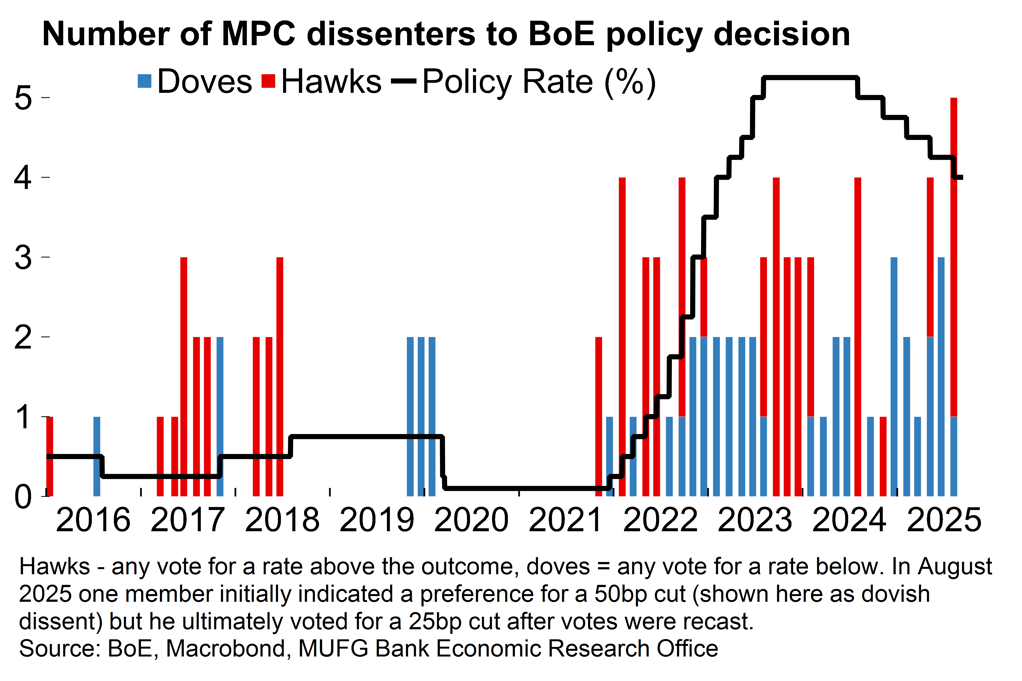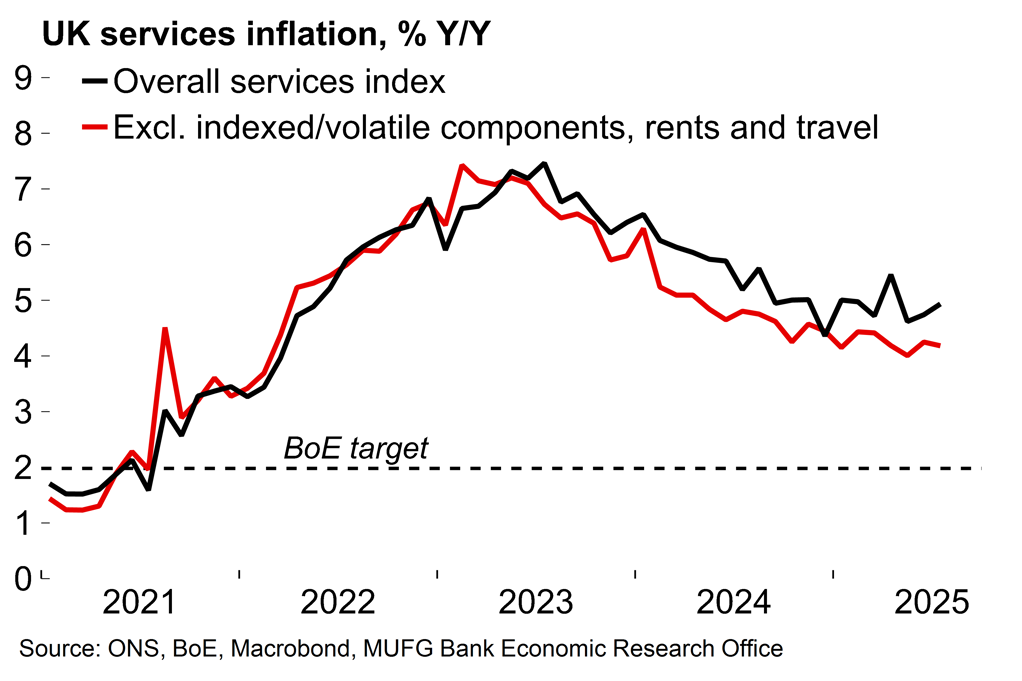- The BoE is set to hold rates at 4.00% next week following August’s narrow vote to extend the quarterly easing cycle. There is no real prospect of a move and attention will centre on the vote split, guidance tweaks and the annual decision on the pace of QT.
- There haven’t been any notable data surprises over the summer. Headline July CPI matched the BoE’s projections and labour market slack continues to build gradually, as expected. That said, signs of rising household inflation expectations today will have been well noted by the hawkish contingent whose argument centres on the risk of pass-through to the wage bargaining process.
- We see a 7-2 split to remain on hold next hold, with Taylor and Dhingra voting for a cut. We expect the guidance will continue to indicate that the likely direction of travel on rates is gradually downwards, but looking ahead the BoE seems set to slow the pace of cuts to reflect the lack of consensus around easing. A December cut still seems plausible, but it would likely be another close call.
- On the balance sheet, a slowdown in the pace of QT from the current 100bn annual pace is widely expected. We’ve pencilled in a shift to 60bn which would entail marginally lower active sales compared to the previous 12 months.
Mixed data unlikely to have reduced fragmentation on the MPC...
The Bank of England meets again next week after the extremely narrow vote to extend its quarterly easing cycle in August. There is no prospect of any action on rates. The focus will instead be on any changes to the guidance, the vote split and the decision on the pace of QT over the next 12 months.
Since the last meeting, UK inflation surprised to the upside, although it was in line with the BoE’s expectations at 3.8% in July. There was a boost from the volatile air fares component and food inflation was slightly stronger than expected. Regarding underlying pressures, the services component accelerated but the BoE’s trimmed services inflation measure (which excludes indexed/volatile components, rents and travel) edged lower to 4.2%. Looking ahead, it is likely that there will be some more pain to come on inflation with a similar headline figure likely next week and the BoE expecting a peak of 4.0% in September.
In other releases, the last batch of official jobs numbers continued to suggest that labour market slack continues to increase gradually rather than abruptly. There are various quality issues around these numbers and so the BoE will continue to place plenty of weight on alternative indicators, and the latest KPMG/REC survey looked soft. On activity, numbers today showed that monthly GDP growth was flat in July. It’s hard to see huge scope for activity to pick up over coming months as speculation around possible fiscal consolidation is set to weigh on sentiment.
All told, there is more than a whiff of stagflation in the air. That is never easy for central banks to navigate and explains the deep divisions, which are likely to endure, on the MPC. Policymakers are weighing the relative risks from a cooling jobs market and sticky inflation expectations. The hawks will continue to caution that higher prices in salient categories might feed through to inflation expectations and the wage bargaining process. That case was bolstered today by the release of the BoE’s quarterly inflation attitudes survey which showed 12-month expectations rose to a two-year high of 3.6%, up from 3.2% in May. The dovish argument, to which we are sympathetic, is that such developments are less relevant in the context of a clearly softening labour market.
The MPC was extremely divided in August

Services inflation remains uncomfortably high

...but the hawks seem to have secured a slower pace of rate cuts
For this meeting, we have pencilled in a 7-2 vote split with Taylor and Dhingra (who are vying for the ‘arch dove’ mantle) voting for a cut. We suspect that Ramsden, who also dissented in June, will now side with the majority for a hold. He said in a speech that his June vote was a close call. He flagged a rise in Google searches for redundancy as a possible leading indicator of faster labour market loosening, but those numbers look less concerning since his comments.
The current guidance for future easing is already cautious (“A gradual and careful approach to the further withdrawal of monetary policy restraint remains appropriate”), but it could be watered down slightly to reflect the fragmentation on the MPC. While we expect more rate cuts (we see the terminal rate at 3.25%), the vote split last time raised plenty of question marks around the timing. Bailey said in his recent Treasury Select Committee appearance that he thinks “the path will continue to be downward” on rates, but “there is now considerably more doubt about exactly when and how quickly” future cuts can be carried out.
So, a slowdown from the established quarterly pace of easing seems likely as a concession to the hawkish camp. Looking ahead, that would mean another hold in November. Only ~9bp of cuts are currently priced by year-end, but we still see scope for a move at the December meeting. By then, the extent of any fiscal consolidation will be known after the Autumn Budget on 28 November. We assume that the chancellor has taken note of measures that might push up consumer prices after the effects of last year’s employer NICs rise.
In terms of upcoming data, the Q3 bump in inflation is likely to have started to fade by December, and we expect activity numbers will come in fairly soft over coming months amid Budget speculation. Meanwhile, the trend for labour market loosening is set to continue and policymakers will increasingly have a better steer on 2026 annual pay settlements, which we think will look increasingly consistent with the BoE’s target. All that said, we accept that the path looks narrow as things stand and any vote for further easing this year is likely to be finely balanced again.
We expect a marked slowdown in the pace of QT
The other key focus will be on the annual decision around the pace of QT, which Bailey said is an “open” discussion. The BoE noted in the August MPR that shifts in the gilt market (lower demand for long-term assets, high issuance and heightened global policy uncertainty) “pose a risk that QT has a greater impact on market functioning”.
A slowdown in the current pace of balance sheet reduction (100bn over a 12-month period) is widely expected. The latest BoE MaPS survey, conducted in late July, showed a median view that the pace will drop to 72bn. But the lumpy maturity profile means that just 49bn of gilts are set to roll off the balance sheet over the next 12 months, and so that consensus would entail an increase in active sales from 13bn over the last 12 months. Given the current market environment, we suspect that the BoE will be wary of surprising market participants to the upside here. We have pencilled in a reduction in pace to 60bn (i.e. similar, but slightly lower active sales over the next 12 months), but we’re not ruling out a pause to active sales altogether.
